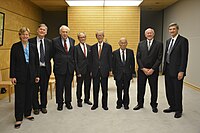Tim Hunt
He was awarded the 2001 Nobel Prize in Physiology or Medicine with Paul Nurse and Leland H. Hartwell for their discoveries of protein molecules that control the division of cells.
While studying fertilized sea urchin eggs in the early 1980s, Hunt discovered cyclin, a protein that cyclically aggregates and is depleted during cell division cycles.
[9] After the death of both his parents, Hunt found his father had worked at Bush House, then the headquarters of BBC World Service radio, most likely in intelligence, although it is not known what he actually did.
At the age of eight, Hunt was accepted into the Dragon School,[8] where he first developed an interest in biology thanks to his science teacher, the German educator Gerd Sommerhoff.
[9] When he was fourteen, he moved to Magdalen College School, Oxford, becoming even more interested in science and studying subjects such as chemistry and zoology.
[9] In 1961, he was accepted into Clare College, Cambridge to study Natural Sciences, graduating in 1964 and immediately beginning work in the university Department of Biochemistry under Asher Korner.
[9] A 1965 talk by Vernon Ingram interested him in haemoglobin synthesis, and at a Greek conference in 1966 on the subject, he persuaded the haematologist and geneticist Irving London to allow him to work in his laboratory at Albert Einstein College of Medicine in New York, staying from July to October 1966.
[9] His PhD was supervised by Asher Korner[2] and focused on haemoglobin synthesis in intact rabbit reticulocytes (immature red blood cells), and was awarded in 1968.
After returning to Cambridge, he again began work with Tony Hunter and Richard Jackson, who had discovered the RNA strand used to start haemoglobin synthesis.
The location provided a ready supply of surf clams (Spisula solidissima) and sea urchins (Arbacia punctulata) amongst the reefs and fishing docks, and it was these invertebrates that were particularly useful for the study of the synthesis of proteins in embryogenesis, as the embryos were simply generated with the application of filtered sea water, and the transparency of the embryo cells was well suited to microscopic study.
[12] It was at Woods Hole around July 1982, using Arbacia sea urchin eggs as his model organism, that he discovered cyclin proteins.
Observing the changes in the bands across the samples, Hunt noticed that one of the proteins rose in abundance before disappearing during the mitosis phase of cell division.
[18] In 1993, the book The Cell Cycle: An Introduction, which Hunt co-authored along with Andrew Murray, was published by Oxford University Press.
[23] In 2010, Hunt joined the Academic Advisory Board of the Austrian think tank Academia Superior, Institute for Future Studies.
[42] In 2001, he was awarded the Nobel Prize in Physiology or Medicine with Leland Hartwell and Paul Nurse for their discoveries regarding cell cycle regulation by cyclin and cyclin-dependent kinases.
[44] In 2006, he was awarded the Royal Society's Royal Medal, two of which are presented annually for "the most important contributions to the advancement of natural knowledge", in his case for "discovering a key aspect of cell cycle control, the protein cyclin which is a component of cyclin dependent kinases, demonstrating his ability to grasp the significance of the result outside his immediate sphere of interest".
